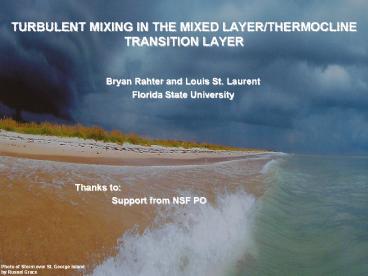TURBULENT MIXING IN THE MIXED LAYER/THERMOCLINE TRANSITION LAYER
Title:
TURBULENT MIXING IN THE MIXED LAYER/THERMOCLINE TRANSITION LAYER
Description:
TURBULENT MIXING IN THE MIXED LAYERTHERMOCLINE TRANSITION LAYER –
Number of Views:52
Avg rating:3.0/5.0
Title: TURBULENT MIXING IN THE MIXED LAYER/THERMOCLINE TRANSITION LAYER
1
TURBULENT MIXING IN THE MIXED LAYER/THERMOCLINE
TRANSITION LAYER
- Bryan Rahter and Louis St. Laurent
- Florida State University
- Thanks to
- Support from NSF PO
Photo of Storm over St. George Island by Russel
Grace
2
Turbulence in the transition layer
Alford (2003)
QuikSCAT winds
- Wind energy input in the inertial band is
generally regarded as a direct source of near
inertial internal waves to the ocean interior. - This is assumed to support turbulent mixing in
the thermocline. - Our study is aimed at quantifying the levels of
turbulence occurring specifically in the
transition layer between the mixed-layer and
thermocline.
3
Turbulence in the transition layer
N2(z)
T(z)
- Many studies focus on turbulence occurring in the
mixed layer - Examples from microstructure studies
- Oakey (1985), Smyth et al. (1996), Anis Moum
(1992), Mickett (2008). - Many other studies focus on the energy transfer
to internal waves in the thermocline. - Examples
- DAsaro (1985, 1995), Alford (2001 2003).
mixed layer
thermocline
4
Turbulence in the transition layer
- However, shear driven mixing in the transition
layer inhibits the near-inertial energy transfer
to waves. - Plueddemann and Farrar (2006)
- The specific properties of this layer are often
ignored in models and observations.
N2(z)
T(z)
mixed layer
transition layer
thermocline
Ef
5
Data used in our study
- We seek
- time-series turbulence data
- spanning mixed layer to thermocline
- documenting open-ocean conditions.
- FLX91 (FLUX STATS)
- Mid-latitude eastern N. Pacific
- April 1991, 6-day time series
- OSU CHAMELEON (Moum)
- Ref Hebert and Moum (1994)
- NATRE (N. Atlantic Tracer Release)
- Mid-latitude eastern N. Atlantic
- April 1992, 25-day timeseries
- WHOI HRP (Schmitt and Toole)
- Ref. St. Laurent and Schmitt (1999)
6
Data used in our study
FLX91
NATRE
7
FLX91 time series
8
NATRE time series
9
NATRE time series
10
Analysis procedure
- We examined between 150 (Natre) and 350 (Flx91)
profiler casts, spanning the length of each
timeseries. - Mixed Layer Base
- - Temp. change gt 0.1oC (from surface)
- - Density change gt 0.025 kg/m3
- Transition Layer Base
- - Based on peak in N2 and
- average N2 for thermocline
- Thermocline
- - 100-m thick layer beneath the transition layer
- The dissipation rate ( ) was averaged by layer.
- The diffusivity was also calculated
N2(z)
T(z)
mixed layer
thermocline
11
FLX91 dissipation rate (W/kg)
12
NATRE dissipation rate (W/kg)
13
Analysis results
- Mean diffusivities for the layers
- (cm2/s)
- mixed layer transition layer thermocline
- FLX91 150 0.3 0.5
- NATRE 37 0.08 0.08
- Ratio of average dissipation between layers with
thermocline - (equivalent to buoyancy flux ratio)
- mixed layer transition layer
- FLX91 171 8
- NATRE 15 4
Why is FLX91 higher?
Exceptional wind events during FLX91 had twice
the energy of those during NATRE
14
Conclusions
- Transition layer dissipation rates are
consistently elevated above thermocline values
(by a factor of 4 to 8). - It appears that the larger dissipation levels of
FLX91 relative to NATRE were correlated to the
peak wind events, rather than mean wind levels
which were comparable. - Why is this Significant?
- - The enhanced dissipation rates in the
transition layer represent - an energy loss term to near inertial waves
emitting from the - mixed-layer base.
- - This implies a reduction in energy available
for turbulent mixing in - the thermocline.






























